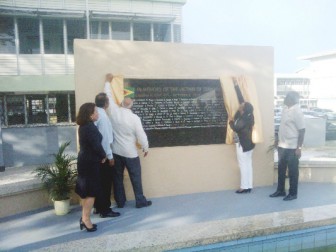– 36 years after tragedy
The memory of the victims of Cubana de Avacion Flight 455 was honoured yesterday with the unveiling of the Cubana 455 Monument at the University of Guyana Turkeyen campus.
President Donald Ramotar described the occasion as a celebration. The President stated that though these individuals would have lost their lives there is still a reason to celebrate. He also stated that that the destructive elements, whose purpose it was to drive a wedge between Cuba, Guyana and other countries who were at the time forging deep relations with Cuba had failed since Cuba-Guyana relations were now stronger than ever. The President also related that countries such as Angola, South Africa, Namibia, and others in Africa are now free, all because Cuba and various other Caribbean countries were not intimidated by the forces working to prevent their cooperation. The monument is strategically placed, said the President, “because five of the passengers that died in this act of terrorism were Guyanese students.”

Minister of Public Works, Robeson Benn, having been in charge of the actual construction of the monument, shared his belief that it not only honours the victims of the tragedy, but also “honours the relatives,” although he acknowledged that no physical monument could attempt to alleviate the loss experienced by the family.
A relative of Rawle Thomas recalled her memory of the day she heard about her younger brother’s demise. Carol Thomas, Rawle’s older sister stated that Rawle was just 18 at the time and was a fresh graduate of Queen’s College. She described him as an individual who took his work his seriously, stating that it was this attitude that won him the scholarship. She shared that she was just around 21 years old and was on her way home from work when she heard a publication on the radio about a plane that went down, but chose to ignore it because “things like that never happened here”. Thomas stated that it wasn’t until she got home that she realised exactly what had happened as there were family and friends crowding the house listening to the radio, which was giving specifics about the plane and everyone on it.
Benn stated that the monument is not just symbolic of what happened on October 6, 1976, but also “a meeting place which would enable visitors to tie into the ambience of the area, a place where students would be able to come to relax, surf the web, and learn about the sacrifice that was made all those years ago.”
“This monument is and forever will be a testament of the pain we feel as a nation and to the hurt felt by the families 36 years and even to this day,” were the words uttered by Dr Frank Anthony, Minister of Culture, Youth and Sports. He went on to say that the monument will serve as a reminder that “this act must never happen again. Terrorist acts must always be rejected,” he said, “and should never, ever prevent progress from occurring.” He too made reference to the fortified relationship between Cuba and Guyana. The minister stated that the significance of this monument is indeed substantial and that work was underway to make the Cubana 455 monument a national monument.
As part of the activities planned to commemorate the unveiling of the monument, Dr Melisha Singh, a graduate of the Guyana-Cuba Scholarship Programme read a list of all 78 individuals who perished on that flight. Among the dead were 11 Guyanese, 5 of whom had secured scholarships to study medicine in Cuba.
“Obviously terrorism did not succeed since we have an even larger number of students going to Cuba yearly to study,” said Benn. Also killed were all 24 members of the Cuban fencing team, who had just won gold in the Central American and Caribbean Championships.
Cuban Charge d’Affaires and Economic and Cultural Affairs Officer, Praxedes Nordet agreed with all that the occurrences of that day were indeed sad, but that all those that lost their lives will not only be honoured, but also immortalized in the monument.
The monument was unveiled by President Ramotar and Nordet, while several government officials including Anthony and Hinds laid wreaths at the feet of the structure where the names of the victims were engraved.
Cubana de Avacion, a Cuban flight from Barbados to Jamaica was brought down by a terrorist attack on October 6, 1976. Of the 73 passengers on board at the time 57 were Cubans, 11 were Guyanese and 5 were Koreans. The crash killed every passenger, as well as the five crew members. Records of the incident stated that 11 minutes after takeoff from the then Barbados Seawell Airport at 18.000 feet. Two bombs, located in the rear lavatory and the midsection of the midsection of the passenger cabin exploded causing fires and rendering the plane uncontrollable. The plane began to descend rapidly while the pilots tried to return to the airport. After realizing this was impossible, the pilots turned the plane away from the beach towards the ocean, apparently to avoid endangering the lives of tourists.




